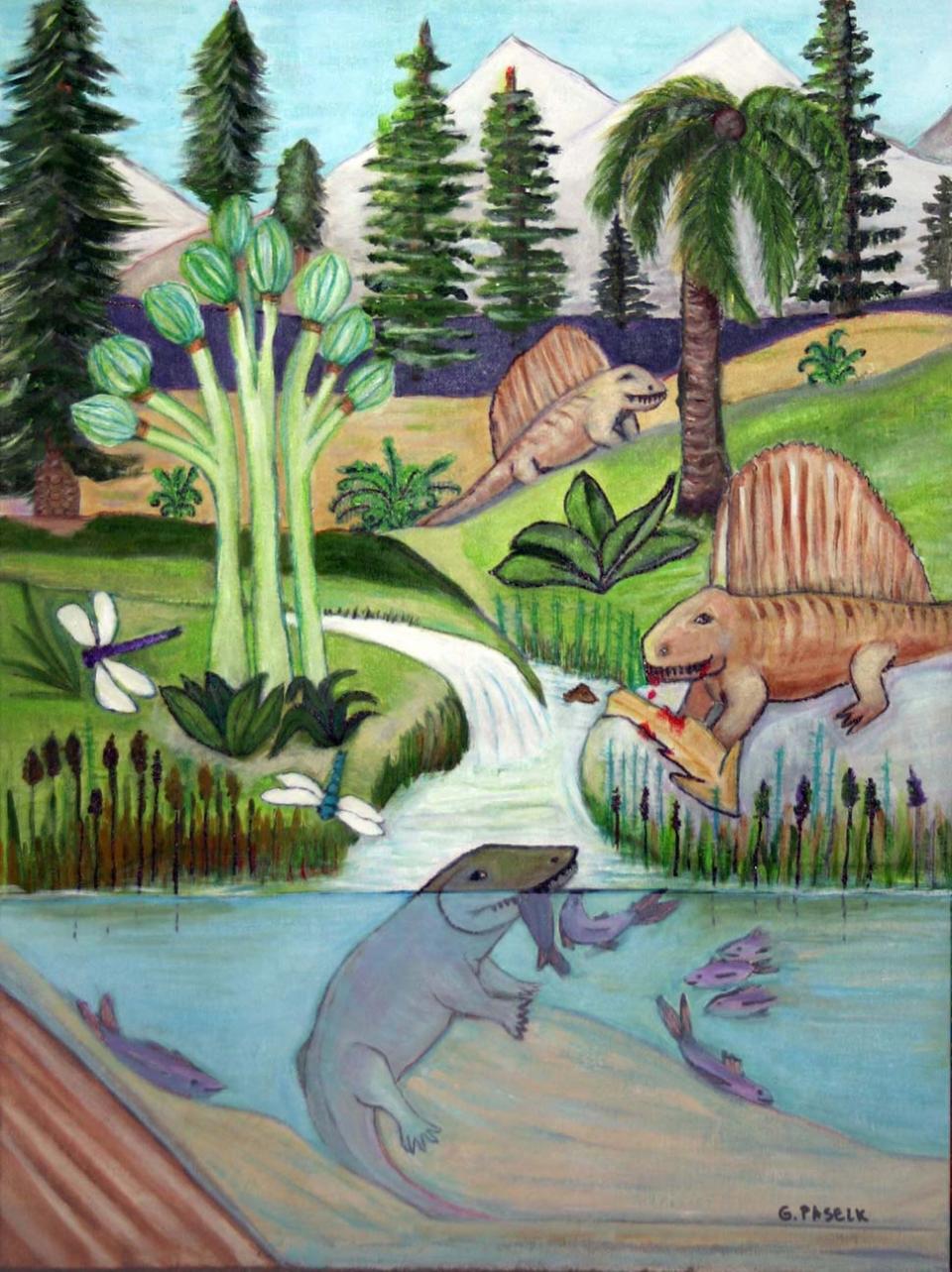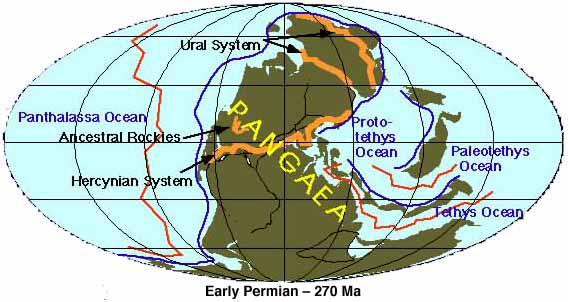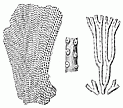
Permian Landscape
© G. Paselk
299.0 to 251.0 Million years ago
Richard Paselk
Plate Tectonic Reconstructions

These maps of major tectonic elements (plates, oceans, ridges, subduction zones, mountain belts) are used with permission from Dr. Ron Blakey at Northern Arizona University. The positions of mid-ocean ridges before 200 Ma are speculative. Explanation of map symbols.
The Permian* was a time of specialization for marine fauna, with major diversifications of ammonoids, brachiopods and bryozoans. A slab exhibiting some of the richness of this fauna is on display. Insects, amphibians, and therapsids (the precursors of mammals) flourished during this time. Reptiles began to flourish in water and on land. During the middle of the Permian there was a major transition in vegetation resulting in a dramatic loss of coal swamps and amphibian habitats. Conifers and other xerophytic seed plants better adapted to the changing climatic conditions and drier (xeric) environments of the Permian appeared and spread. Competition in the dry climate belts lead to more diversity and variability in seed plants. Continuing evolution of arthropod herbivores and the first appearance of vertebrate herbivores encouraged plant evolution in new directions.
Insects were the most important herbivores of the early Permian. Non-metamorphosing insects related to grasshoppers and cockroaches from the Pennsylvanian were joined by the first known insect groups to undergo metamorphosis. These new insect types, such as beetles, gained the advantage of the larvae and adults utilizing different ecological resources, profoundly affecting insect-plant and insect-predator interactions and coevolution. With these new forms insects reached their highest diversity of high-level forms of all time.
Most major groups of terrestrial vertebrates were present in the Permian. A wide variety of amphibians lived on land and in fresh water, including the giant carnivorous Eryops as well as large herbivores. The two major amniote vertebrate groups, synapsids (mammal-like reptiles) and diapsids (true reptiles) had diversified into many groups, including some of the first large vertebrate herbivores. While reptilian carnivores radiated to many forms and niches through the Permian, the invention of herbivory was the important and complex vertebrate adaptation. Plant material not only requires special mechanical adaptations to breakdown vegetable material, it is also largely indigestible, requiring specialized symbiotic relationships with fermentative bacteria.
The Permian is the last Period of the Paleozoic Era. It ended with the greatest mass extinction known in the last 600 million years. Up to 90% of marine species disappeared from the fossil record, with many families, orders, and even classes becoming extinct. On land insects endured the greatest mass extinction of their history. Among the animal groups suffering major extinctions were the trilobites, rugose and tabulate corals, blastoids, placoderms and pelycosaurs. Other animal groups suffering extensive reductions included the brachiopods, bryozoans, ammonoids, crinoids, sharks, bony fishes, euryptids, ostracodes and echinoderms. A variety of spore-bearing plants also became extinct. The extinctions were spread equally across terrestrial and marine environments.The most likely cause of this extinction event was the massive volcanic eruption that gave rise to the "Siberian Traps" in what is now Russia. This event covered an area of about two thirds of the U.S. with a total volume of 1–4 million cubic kilometers of lava. The vast quantities of volcanic gases released would have changed Earth's climate as well as poisoning the environment. Recent research has shown that these flood basalts were released at almost exactly the same time as the Permian extinction event—a strong argument for their causality.
All of the continents remained fused together in the supercontinent Pangea during this Period, which moved to the north. The climate began cool and humid with a carboniferous type of flora. It then transitioned to a warm and arid regime favoring more modern plant types that could colonize the dry land as sea levels fell. There was a dramatic loss of coal swamps and amphibian habitats. The climate now favored more modern plant types, which could colonize the dry land as sea levels fell.
*The Permian was named in 1841 by Murchison in collaboration with Russian Geologists for the beds lying above Carboniferous strata in the ancient Kingdom of Permia and the city of Perm in the Ural mountains of Russia.
Permian Animal (Metazoan) Fossils
Trilobites (ToL: Trilobites<Arthropoda<Ecdysozoa<Bilateria<Metazoa<Eukaryota)

Trilobites
The Permian saw the last of the trilobites: none survived the great extinction event. Specimens of individuals of two species and an assemblage of a third are displayed:
Vertebrates (ToL: Chordata<Deuterostomia<Bilateria<Metazoa<Eukaryota)

Amphibians
Extinct amphibians are well represented in the Permian fossil record. Permian amphibians were generally large, such as the 5-6 ft. long Eryops represented by a skull cast in our display. However, there were also small species, such as the salamander-sized specimen of Branchiosaurus in this case.
Eryops megacephalus skull cast. This amphibian was well adapted to both terrestrial and aquatic environments. It was alligator-like in both appearance and habit.
![]() Side view
Side view Front view
Front view![]() life reconstruction
life reconstruction
![]() Inside roof of mouth, showing palatal teeth
Inside roof of mouth, showing palatal teeth
Branchiosaurus (Apateon sp.), a small (6 in), common amphibian fossil. This prehistoric amphibian once inhabited the Permian swaps. Its external gills protruded from each side of its head and enabled the amphibian to breathe under water indefinitely. While named as a separate species, these fossils may actually represent the larvae of a larger amphibian.
![]() Apateon sp.
Apateon sp.  Life reconstruction
Life reconstruction

Reptiles
Reptiles (Reptilia) have an abundant fossil record in this period. The display includes:
 a slab with small reptile footprints,
a slab with small reptile footprints,
A mounted specimen of a lizard sized Captorhinus aguti, a member of the extinct captorhinids (Captorhinidae<Romeriida<Reptilia). These primitive reptiles were a closely related sister-group to the diapsids (Diapsida<Romeriida<Reptilia), which includes birds and all modern reptiles other than turtles. This early herbivorous tetrapod was one of the first reptiles to appear in the fossil record. A close-up image of the skull is also provided for this specimen.
 Captorhinus aguti;
Captorhinus aguti; ![]() life reconstruction
life reconstruction
A cast of Permian reptile egg. Unlike amphibians, reptiles were able to move away from bodies of water due to their desiccation-resistant eggs.
![]() reptile egg (cast)
reptile egg (cast)
A small, very complete mesosaur, Mesosaurus braziliensis (Mesosauridae<Anapsida<Reptilia) is featured. This crocodile-like reptile is known from both Africa and South America. Its occurrence supported the idea that these continents were once fused together in the supercontinent Pangaea.
![]() Image of mesosaur fossil; High Res image of fossil;
Image of mesosaur fossil; High Res image of fossil;  life reconstruction
life reconstruction
Brachiopods (ToL: Brachiopoda<Lophotrochozoa<Bilateria<Metazoa<Eukaryota)

Brachiopods
Brachiopods were an important part of the marine fauna for the last time during the Permian, bordering on extinction ever since. Multiple specimens of three species represent brachiopods in this display:
Cleithytidina orbiscularis (Three specimens, each about 1/2 inch diameter, multiple views showing characteristics)
Hustedia mormoni (Three specimens, each about 1/2 inch diameter, multiple views showing characteristics)
 Composita sp. (Three specimens, each about 1 inch diameter)
Composita sp. (Three specimens, each about 1 inch diameter)
 Unidentified brachiopods (some indicated with arrows) on assemblage slab.
Unidentified brachiopods (some indicated with arrows) on assemblage slab.
Moss Animals (ToL: Bryozoa<Lophotrochozoa<Bilateria<Metazoa<Eukaryota)

Bryozoans
The reticulated fan-shape objects (arrows) on this slab are moss animals or bryozoans.
Corals (ToL: Cnidera<Metazoa<Eukaryota)

Corals
Cnidarians (corals): The horn (rugose) corals, such as these examples of solitary coral, and the tabulate corals disappeared forever at the end of the Permian.
Permian Protozoan Fossils
Foraminiferans (ToL: <Protozoa<Eukaryota)

Foraminiferans
The small (rice-grain size, some indicated by arrows) objects all over this slab are fusilinide foraminiferans, a colonial protozoan which make spiral, rice-grain shaped shells of calcium carbonate. Fusinilides were among the major groups to dissapear with the Permian extintion event.
Permian Plant Fossils
Vascular Plants (ToL: Embryophytes [land plants] <Green Plants<Eukaryota)

Seed Ferns
Pteridospermophyta (seed ferns) are represented by a slab with leaves from Glossopteris sp. and Gangmopteris sp. and a second slab with Glossopteris sp. alone.
 Glossopteris sp. and Gangmopteris sp
Glossopteris sp. and Gangmopteris sp

Conifers
Conifers readily colonized dry land and increased their abundance during this time. They are characterized by their reproduction via cones. Two specimens of fossil branches and foliage are displayed: Lebachia piniformis and conifer sp.
The engravings of Permian fossils are from Dana, James D. (1870) Manual of Geology; Le Conte, Joseph (1898) A Compend of Geology; Grabau, Amadeus (1901) Guide to the Geology and Paleontology of Niagra Falls; Shimer, Hervey Woodburn (1914) An Introduction to the Study of Fossils, or Pirson, Louis and Charles Schuchert (1920) A Text-Book of Geology.
©1998, Cal Poly Humboldt NHM | Last modified 30 October 2012

 Delaria sp
Delaria sp Ditomopygie sp
Ditomopygie sp Kaskia
Kaskia  top view
top view side view
side view valve view
valve view top view
top view side view
side view valve view
valve view moss animals or bryozoans
moss animals or bryozoans solitary coral
solitary coral fusilinide foraminiferans
fusilinide foraminiferans Glossopteris sp.
Glossopteris sp. conifer sp.
conifer sp.